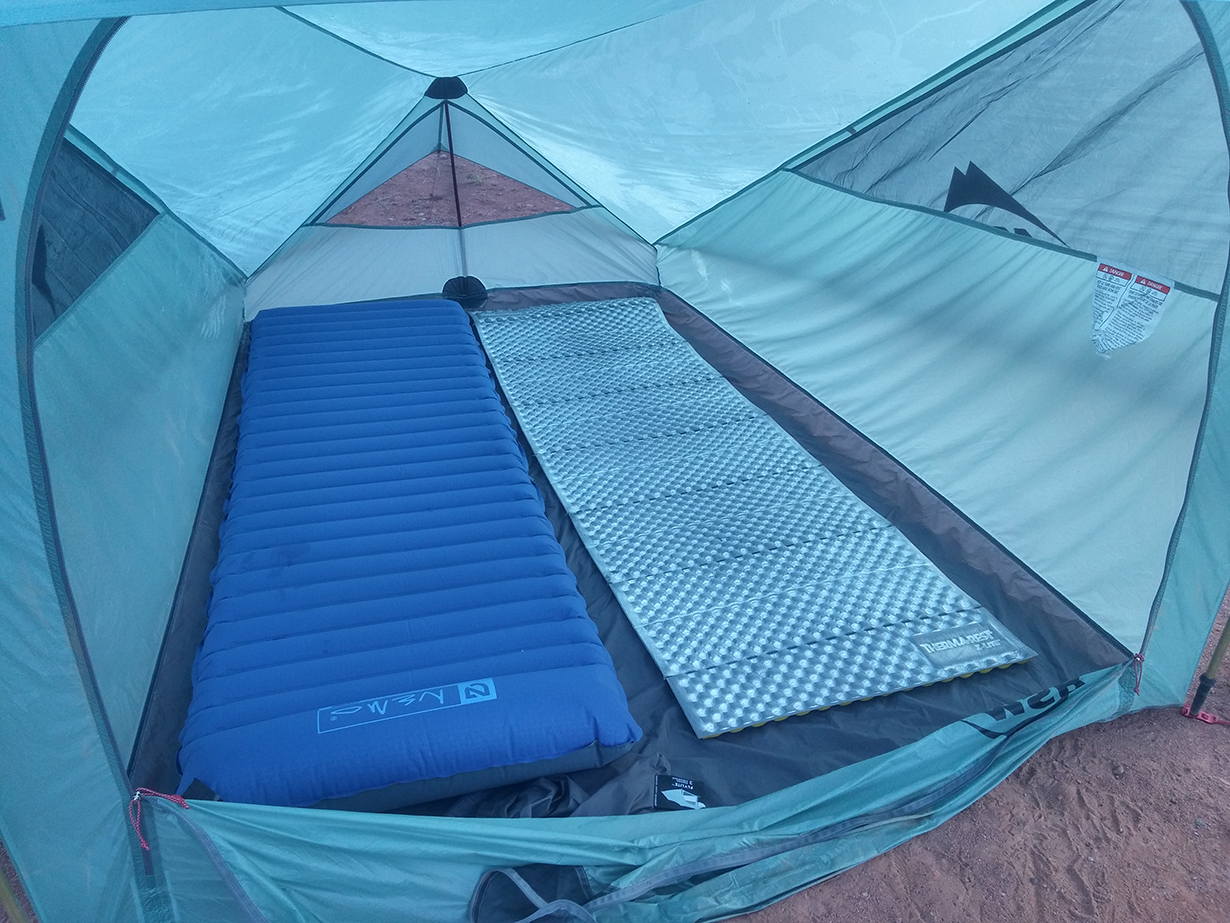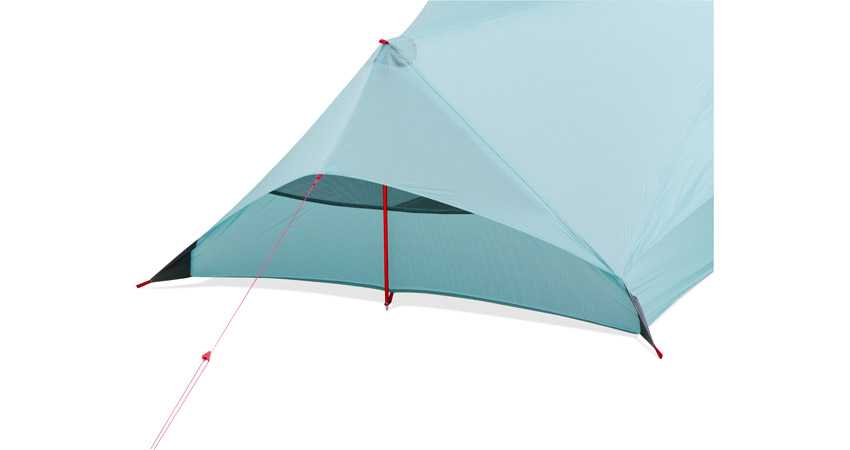Interior Space
If you often bring poles with you anyway and you’re still with me on this, then using a minimalist shelter is a fantastic way to trim your pack’s base weight. Compared to ultralight freestanding tents, the Flylite has vastly more interior space. While the Flylite only has 1 more square foot of floor space compared to the Big Agnes Fly Creek HV2 Platinum, the Flylite not only has a much higher peak height, but its higher ceiling covers a greater portion of the footprint, amplifying the interior space. Simply put, most freestanding ultralight tents marketed for two people are really meant for 1.5 people, and can work with two if necessary. But the Flylite has plenty of room for two people.

So the Flylite is lighter and roomier than most freestanding tents, but how does it compare to other ultralight shelters? With a packed weight of 1020 g, the Flylite weighs more than both the 848 g Hyperlite Mountain Gear Echo II and the 595 g Zpacks Duplex. Both the Echo II and Duplex consist of mesh and cuben fiber and rely on trekking poles for support, a construction that is about as lean as possible for shelters that offer full enclosure. Although it’s a bit heavier, the Flylite is far and away the best in terms of usable space, due to the geometry mentioned previously.
Vestibule Space
None of these shelters offer much in the way of additional vestibule space, but that’s an entirely intentional result of removing as much extra fabric as possible. Rather than citing this as a design flaw, I mention it only as something that needs to be considered as part of the decision to go for a minimalist shelter (as opposed to the aforementioned freestanding, double-wall tents).
Ventilation
The other major functional difference is that the Flylite has extremely poor airflow relative to the double wall options. I sat out a good soaking in Utah in the Flylite, and while I appreciated the mesh panels, they still didn’t match the circulation of double wall tents. No water soaked through the nylon fabric of the Flylite, but the nature of single wall tents means that it takes longer for any dampness to leave the tent.
Price
Where the Flylite really separates itself from its competitors is the price. At $350, the Flylite may seem expensive when compared to typical backpacking tents. However, in the niche world of minimalist shelters, this puts it $250 dollars under the Zpacks Duplex, and at half the price of the Hyperlite Mountain Gear Echo II. For most backpackers, this is likely the most salient detail in the discussion, and something that makes the Flylite stand out.
Setup and Durability
If you’re contemplating a step into non-freestanding shelters, there’s a bit of a learning curve with setting them up. Because the guy wires must be tensioned for them to stand, there’s some skill involved in applying and evenly distributing that tension. For the Flylite, this process isn’t particularly tricky, but I would recommend reading MSR’s instructions for properly staking out the shelter. The stakes MSR uses with the Flylite are notched in a way that works great for hooking the thin guy wires, but they’re not ideal for the sewn loops that stake the floor of the tent to the ground. Stakes that accommodate the wider fabric would be a welcome, if minor, improvement.

Lastly — and this is really a PSA-reminder — ultralight, minimalist equipment is not as durable as equipment made with heavier-denier fabrics. When reducing weight, each gram is harder to cut than the last, so taking appropriate care of your gear becomes increasingly important. That being said, after my twenty or so nights in the Flylite plus all the corresponding stuffing in and out of packs and cars, the shelter has shown impressively little wear on the tent itself, though I did snap one of the guy wires while getting one of the stakes out of frozen ground.
Bottom Line
All told, the MSR Flylite 2-Person Trekking Pole Shelter is the best-value minimalist shelter I’ve used. It’s got much of the appeal of other minimalist options but does especially well when comparing interior space and price. If you’re very concerned about weight or you have your systems fully dialed and want more control over your shelter configuration, there are lighter and more modular options available. But those other options will sacrifice some space and cost a bit more.
With that in mind, you might be tempted to think of the MSR Flylite as a minimalist shelter with training wheels, caught in between truly minimalist shelters and freestanding, double-walled tents. But that undersells it. The Flylite is a legitimate and excellent option at a much lower price than many alternatives. The users who are going to be best served by the MSR Flylite are backpackers and thru-hikers who have enough experience to start thinking about slimming down their load and already carry trekking poles, but who still want some extra protection for sub-optimal conditions.

Sierra Designs Tensegrity 2 FL is amazing. Same weight category, with ventilation, and versatility. Love that tent after a PCT thru-hike in 2016.
We’ll check it out- Thanks, Travis. and congrats on the thru-hike! I did about 900 miles scattered across California and Washington and it was some of the best hiking I’ve ever done in my life.
Tarptent brand shelters are stupid light and often double-walled. I swear by them.
Agreed- for serious backpacking they’re pretty hard to beat.